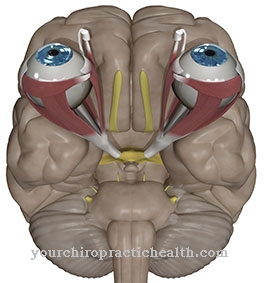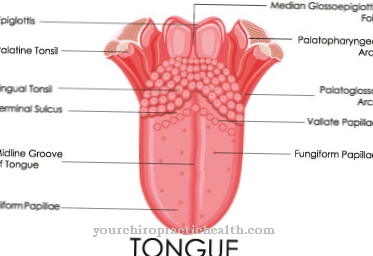Androgenetic alopecia is a hormonal hereditary hair losswhich is caused by an innate hypersensitivity of the hair follicles to the male sex hormone testosterone. Around 80 percent of men and almost 50 percent of women suffer from hormonally hereditary hair loss in the course of their lives.
What is hormonally hereditary hair loss?
.jpg)
© Petrik - stock.adobe.com
As hormonally hereditary hair loss (alopecia androgenetica) This is the term used to describe hair loss of the scalp which is due to a genetically determined hypersensitivity of the hair follicles to male sex hormones (androgens), especially testosterone, and which primarily affects men.
In the case of androgenetic alopecia, a distinction is made between the male and female types. The male type of androgenetic alopecia usually begins in early adulthood, possibly already during puberty (alopecia prematura), and manifests itself at the beginning on both sides frontotemporally (at the lateral forehead attachments) through the so-called receding hairline.
The initially slowly progressing hair loss in the vertex area develops in the further course chronically in phases to a bald head (calvities) with a recess on the back, lateral hairline (tonsure). The female type of hormonally hereditary hair loss has a later onset, mostly during or after the menopause as a result of the hormonal change. Alopecia androgenetica of the female type is manifested by a diffuse clearing in the crown area with a frontal strip of hair cut out.
causes
A Androgenetic alopecia is a polygenic (due to several genes) caused hair loss, which is due to an over-sensitivity of the hair follicles to male sex hormones (androgens), especially to the active form dihydrotestosterone of testosterone.
The hypersensitivity leads to a disruption of hair growth and to a shortened growth (anagen phase) and life phase of the hair follicles, which increasingly atrophy (shrink) and produce thin, short woolly hairs (vellus hairs), which may fall out without new hair growing back.
As a result of the hormonal change during the menopause, the estrogen level drops and the influence of male sex hormones, which are also produced in small quantities by the female organism, increases. This changed testosterone-estrogen ratio can not only lead to the so-called lady's beard, but also to hormone-related hair loss.
Symptoms, ailments & signs
Those affected usually notice noticeable hair loss. You can lose more than 100 hairs a day. In most cases, hereditary hair loss begins with a visible thinning of the individual hair.At the same time, these are no longer growing as fast as they were before. Those affected sometimes also notice this when the hair takes a long time to grow back after visiting the hairdresser.
Typically, so-called vellus hairs form on the top of the head. In general, the hair is no longer as thick as it was before. Sometimes there are also individual spots that are completely bare. This usually begins with the so-called receding hairline on the side of the forehead above the temples. Then it gradually expands to other areas.
In both men and women, this can affect the back of the head as well. In some cases, a ring of hair can form on the sides of the head and the lower back of the head. In its advanced stages, hormonally hereditary hair loss rarely leads to baldness. The hormonally hereditary hair loss only affects the scalp hair. Eyelashes, eyebrows, beard hair, intimate and body hair are usually not affected.
Diagnosis & course
A Androgenetic alopecia can be diagnosed with a physical exam based on the pattern of hair thinning. The diagnosis can be confirmed with the help of a trichogram. In a trichogram, epilated hair (taken from the forehead with a clamp) is analyzed with regard to its hair root status, hair distribution pattern and growth behavior.
In the case of hormonally hereditary hair loss, for example, there is a shortened anagen phase (growth phase). In addition, a trichogram provides information about the intensity of androgenetic alopecia.
The course and prognosis are difficult to predict in the case of hormonally hereditary hair loss, as the different therapeutic measures result in individually different therapeutic successes. If left untreated, hair loss in androgenetic alopecia will gradually continue.
Complications
As a rule, hair loss does not represent a health-threatening condition for the patient and thus does not lead to particular complications or complaints that could negatively affect the patient's health. However, in many cases, hair loss leads to psychological complaints and thus to depression. Most people feel uncomfortable with hair loss and suffer from decreased self-esteem.
In the worst case scenario, this can even lead to thoughts of suicide. Children in particular can be bullied or teased by this disease. Not infrequently, hair loss also leads to the development of so-called receding hairlines, which can also lead to feelings of shame. Many of those affected no longer take an active part in social life or are marginalized.
Hair loss can be treated relatively well with the help of medication or a transplant and does not lead to any further complications. However, there is no guarantee that the disease will progress positively. It is not uncommon for the drugs used to lead to various side effects in the patient. The hair loss, however, has no influence on the life expectancy of the patient.
When should you go to the doctor?
To clarify the cause, a doctor should always be consulted if hair loss begins. As the symptoms can have various causes, an examination is recommended. In some cases there may be a condition with serious consequences and this should be ruled out. If the hair loss causes emotional or psychological impairment, a doctor's visit is advisable. Swelling of the scalp, redness, itching or scarring on the scalp should be examined and treated.
In the event of inflammation, pimples or cracks on the head, a doctor's visit is advisable. If sleep disorders, decreased self-esteem or headaches develop, a doctor is needed. A doctor should be consulted in the event of changed behavior, depressive or melancholic phases or social withdrawal behavior. A visit to a doctor is recommended if changes in personality develop as a result of the visual flaw and if well-being drops immensely.
People who experience a reduced quality of life or persistent malaise due to hair loss should seek medical or therapeutic help. Since, from a medical point of view, there is no health-threatening condition, especially with hormonally hereditary hair loss, a cosmetic surgeon can achieve permanent aesthetic changes in many patients. It is therefore advisable to take advantage of a consultation and information session about the various options.
Doctors & therapists in your area
Treatment & Therapy
At a hormonally hereditary hair loss various therapeutic measures are available. Since the hair follicles of the back of the head are not affected by the hypersensitivity to testosterone in the case of hormonally hereditary hair loss, residual hair from this area can be transplanted to the bald spots as part of a hair transplant.
There is also the option of a hair transplant with synthetic hair. In addition to these cosmetic surgical interventions, the progression of hair loss can be stabilized through drug therapy. In the beginning, hair tinctures with anti-androgenic ingredients such as minoxidil or 17-alpha-estradiol are regularly massaged into the scalp. If there is no improvement after three to six months, therapy with tablets may be indicated, whereby depending on the gender, different active ingredients are used for hormonally hereditary hair loss.
If the hair follicle activity is sufficiently high, finasteride can be used in men with alopecia androgenetica. As a result of the synthesis of active dihydrotestosterone from testosterone, which is inhibited by finasteride, hormonally-related hair loss (around 80 to 90 percent) is stabilized in the majority of those affected and hair thickening is caused in a good half.
However, finasteride can negatively affect libido and potency in higher doses. Female sex hormones (gestagens, estrogens), which have an antiandrogenic effect, are usually used in female patients. For example, combined preparations made from chlormadinone (gestagen) and ethinylestradiol (synthetic estrogen) and with individual preparations made from chlormadinone, ethinylestradiol and dienogest have achieved good therapeutic results for androgenetic alopecia in women after menopause.
You can find your medication here
➔ Medication for hair loss and baldnessOutlook & forecast
The chances of reducing hair loss are difficult to predict. Some of the patients hardly or not at all respond to medication. In other men and women, drug therapy approaches lead to a decrease in symptoms. It is only six months after the start of taking it that it is clear whether the form of therapy was successful or whether the process of hair loss intensifies again.
A complete regeneration of the previous hair density is prognostically excluded. Prescription-free treatment attempts lead to visible success against the progression of hair loss in the long term. However, the positive prognosis depends on the regular use and tolerance of such tinctures. As with medication, the scalp needs to be treated over the next few years, if possible without a break in use.
Without treatment, men sooner or later tend to go bald. This can only be eliminated by a complex hair transplant and often leaves visible signs of artificial production. In women, the overall hair fullness can improve again. Nevertheless, the still intact hair remains thinner than before due to the hereditary predisposition. Symptoms can be alleviated once the menopause has finally entered the stage. But to do this, the hormonally hereditary cause of the hair loss should be diagnosed at the beginning of the menopause, if possible.
prevention
Against a hormonally hereditary hair loss so far there are no preventive measures.
Aftercare
Follow-up care for hormonally hereditary hair loss depends on the therapy in question. If the person concerned has been treated with hormonal medication, the amount and use of these drugs as well as their effects must be repeatedly and permanently monitored. The control is important in order to document the progress or lack of it and to change the treatment if necessary.
In the case of a transplant, it is also advisable to take a regular look at the scalp and hair appearance. The transplantation sites and sutures must also be checked closely immediately after the operation, and then checked at longer intervals. If the hair pattern changes in other areas over time, the transplanted areas and the new bald areas no longer fit together and advice must be given on how to proceed.
If, on the other hand, no treatment or therapy has worked or nothing has been done, the person concerned can make do with a wig for the future, whereby first-class wig studios are preferred in order to achieve a good look. In the case of hereditary hair loss, there is the right to a prescription for a human hair wig per calendar year. This prescription can be issued by the dermatologist or the family doctor. The person concerned may have to make additional payments if a higher-priced model is chosen.
You can do that yourself
People with hormonally hereditary hair loss can use a variety of measures, home remedies and aids to alleviate or at least conceal the symptoms. First, however, you should go to the family doctor with the condition. The doctor can determine without a doubt whether it is actually hormonally hereditary hair loss and then suggest suitable therapeutic measures.
In general, a healthy and balanced diet is recommended. If you eat a lot of fruit and vegetables and drink enough, you will strengthen the hair roots and naturally prevent hair loss. Regular exercise has a similar effect. Exercise strengthens the immune system and prevents stress - a key factor in hair loss.
Tried and tested natural products are aloe vera and amla oil. A classic base cure can also reduce hair loss and make the scalp hair thicker. A budget resource: beer. The drink is applied to the scalp as a shampoo and revitalizes the hair roots in a natural way thanks to its strengthening ingredients. Another home remedy is an infusion of onion cubes and rubbing alcohol. Also massaged into the scalp, the brew reduces hair loss and also prevents dandruff.



























